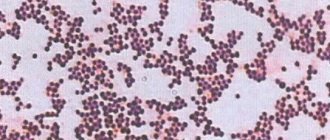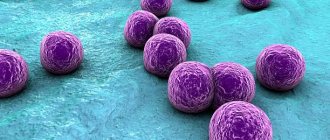Back to list Previous article Next article
07.12.2021
Tags:
staphylococcus aureus, Staphylococcus aureus
Vote
Staphylococcus aureus is a pathogenic variety of staphylococci that causes purulent-inflammatory lesions of organs and systems. The pathogen is diagnosed in the axillary region and nasal passages. Healthcare workers with certain types of dermatitis are considered carriers of the pathogenic microorganism. In healthy people, Staphylococcus aureus is normally detected in the nasal passages, larynx, perineum, scalp, and gastrointestinal tract.
Staphylococcus
Staphylococcus is one of the most common pathogens.
The presence of bacteria in the body provokes a decrease in the efficiency of organs. During medical diagnosis, it can be detected on the skin and mucous membranes, and the patient does not always feel a deterioration in health. Carriers are often adults. Not in every case, the presence of a staphylococcal irritant provokes the development of infection. The course of the disease depends on the location of the purulent focus. Staphylococcus in adults can cause boils, pneumonia due to the penetration of bacteria, poisoning, meningitis, blood poisoning, bronchitis and endocarditis. Staphylococcus aureus is considered extremely dangerous to health and can cause damage to any organ. When faced with the need to purchase medication, use your doctor’s instructions and choose medications on the website
Symptoms
A minimal amount of bacteria in a smear is not a cause for concern. If they begin to reproduce (if conditions are favorable for this), the following symptoms may appear:
- Nervousness and irritability.
- Burning sensation, itching, intensifying at night.
- Vaginal discharge, which may vary in color and smell.
- Pain and discomfort during and after sexual intercourse.
- Increased body temperature, feverish conditions.
- Decreased appetite.
- Pain in the lower abdomen during urination.
- Menstrual irregularities or painful periods with heavy (scanty) discharge.
How is staphylococcus transmitted?
You can become a carrier by accident: in transport, at work, at school, in nature, by getting damaged skin or by “capturing” the microorganism along with food or water. Signs of the disease appear after the following contacts:
- household
- airborne
- fecal-oral
- vertical (from mother to child)
The microorganism is resistant to temperature and physical influences, so it can linger on surfaces for up to six months.
Treatment for intestinal infection in the uterus
The goals of therapy are:
- elimination of E. coli;
- prevention of chronic inflammation;
- restoration of the menstrual cycle;
- preservation of a woman's reproductive function.
Both acute and chronic inflammatory processes in the uterus caused by an intestinal infection require antibacterial therapy. For symptomatic treatment, painkillers, restorative and immunostimulating agents, and probiotics with lactobacilli are used. Physiotherapy is used to treat damaged endometrium and restore the menstrual cycle.
Symptoms of staphylococcus in children and other risk groups
People with weak immunity, diabetes mellitus, and diseases of the endocrine system are the most susceptible to attacks by harmful microorganisms. At risk are patients with chronic illnesses, newborns, pregnant women and the elderly. The key factors for staphylococcus and its development are colds and respiratory diseases. It often turns out to be an unpleasant consequence of the flu.
Those who cannot give up alcohol, smoking and are accustomed to abusing junk food are also at risk. Inflammation is also detected as a result of neglect of hygiene rules. It is important to ensure compliance with simple requirements for body care when raising children, and not to neglect them in adulthood.
“Flora smear”: what will the analysis tell you?
The “Flora Smear” study refers to a microscopic type of analysis. The test is prescribed if an infection of the reproductive organs is suspected. To carry out the analysis, you need to obtain a smear. In men, the biotope is the urethra, in women - the cervical canal, vagina, urethra. Based on the location of the pathological process, the doctor can direct the woman to take a smear only from the vagina or cervical canal. However, more often all three loci are required at once.
| Taking a smear is a painless and safe procedure. All pregnant women also undergo a smear test at least three times: the first visit, 30 and 36 weeks, subject to a normal pregnancy. The resulting smear is transferred to glass, dried and stained, after which a laboratory doctor examines the preparation under a microscope and describes it. The result form contains information about microflora, leukocytes, epithelial cells and pathological agents. |
Microflora
During the analysis, the doctor describes its type and abundance. Normally, rod flora should predominate. The rods are representatives of lactobacilli and maintain a certain pH level. The main role of the sticks is to protect the vagina from pathogens and stimulate local immune reactions. When other bacteria, such as cocci, are present in the smear, the number of rods decreases. This condition indicates dysbiosis and requires mandatory correction.
Leukocytes
Leukocytes in a smear indicate the presence of an inflammatory reaction. The number of leukocytes in the “results” column is indicated with a hyphen. The first and second digits correspond to the minimum and maximum numbers found in the microscope's fields of view. Each locus has its own reference indicators. In the cervical canal no more than 25 cells per field of view are allowed, in the urethra - no more than 5, in the vagina - no more than 10.
An increase in the absolute number of leukocytes indicates inflammation, so it is necessary to consult a gynecologist or urologist.
Epithelium
Epithelial cells in the preparation are arranged in layers or scattered in the form of individual cells. In a smear their number should be single. In the case of an increase in the number of epithelial cells, the doctor indicates: moderately means that there are up to 10 epithelial cells in one field of view, a lot - up to 20, abundantly - over 25.
Changes in the size and morphology of epithelial cells may indirectly indicate an inflammatory reaction or hormonal problems. Epithelial cells covered over the entire surface with cocci are called “key cells.” Their detection in a smear is a morphological criterion of bacterial vaginosis.
Slime _
The values “little”, “moderate”, “absent” are a variant of the norm. If mucus is present in larger quantities, then this is a sign of dysbiotic disorders in the vagina.
Pathological elements
In a smear, the doctor can identify the mycelium and spores of yeast-like fungi, trichomonas, actinomycetes, sperm, etc. But he will not be able to determine the exact species of the pathogen due to the limitations of the method. For example, in the human urogenital tract there are several representatives of the genus Neisseriaceae, which are similar to each other, so it is not possible to distinguish them in a standard microscope.
The diagnostic sensitivity of microscopy in diagnosing gonococcal infection in Russia is 30%, and trichomonas infection - 44–68%. Microscopy is descriptive; to accurately determine the type of pathogen, it is necessary to use molecular biological methods (PCR, NASBA) and the cultural method.
Risk groups: pregnant women
Human immunity is able to control infection, but not in all cases. For example, the female body is exposed to harmful bacteria, but its natural defense blocks the action of a saprophytic bacterium, which is dangerous because it is accompanied by inflammation of the kidneys and bladder. Staphylococcus is often detected in pregnant women, since during this period the expectant mother’s immunity weakens.
Doctors suggest taking a test to determine the presence of infection. It is not always active, so treatment is not required in every case. In some situations, preventive measures are sufficient to avoid unpleasant consequences. Contact with Staphylococcus aureus during pregnancy is dangerous for the woman and baby, because the bacterium can infect the membranes and fetus. If such a variety is detected, the doctor tells you how to get rid of staphylococcus in the body.
Intestinal diseases
Taking a smear for staphylococcus
Staphylococcus aureus often causes intestinal inflammation. The appearance of such a pathology may be associated with food poisoning or other factors. The disease is called bacterial gastroenteritis.
The effect of bacteria on the intestinal wall can cause fluid retention and interfere with the absorption of nutrients. The patient often experiences acute symptoms, including fever, vomiting, severe abdominal cramps, and diarrhea.
The course of bacterial gastroenteritis can range from mild to very severe. There is always a risk of acute loss of body fluids, which is usually associated with vomiting and diarrhea. This disease can be observed against the background of an improper diet, malabsorption syndrome and other pathologies.
The disease often resolves on its own, but improper treatment of the acute form of the infection can lead to the development of a chronic process. It is also important to stay hydrated, as dehydration can be fatal.
Bacterial gastroenteritis can be the result of poor hygiene. Infection can occur after close contact with animals or consumption of food contaminated with bacteria.
Staphylococcus in children
A child is less resistant to infection because his immune system is not as stable as that of an adult. Treatment of staphylococcus in children and regular prevention of the disease are important, since the bacterium often provokes diseases, which include:
- pneumonia
- sinusitis
- rhinitis
- bronchitis
- pharyngitis
Skin lesions are a symptom of the disease that manifests itself at a young age. The disease is easily confused with an allergy. Staphylococcus in the intestines causes gastrointestinal disorders, and purulent staphylococcus causes poisoning with toxins produced by harmful microorganisms.
Infants require close attention in this matter. Staphylococcus is common in newborns and can become a prerequisite for health problems in the future. The most terrible consequence of infection is the pathogenic process in fatty tissues and, as a result, necrosis.
Diagnostic search
For a proper diagnosis, you need to see a doctor. But it is worth conducting research only if there are symptoms. The fact that biological material contains staphylococcus is an absolute norm. Initially, you need to collect the material. Be sure to conduct dynamic tests. If the number of bacteria constantly increases, this is a staphylococcal infection. It is necessary to understand what type of infection caused it in order to choose the right treatment tactics for Staphylococcus aureus .
diagnosis of staphylococcus
Diagnosis and treatment of the disease
Staphylococcus in the throat, nose, and blood is detected as a result of examination. The diagnosis is made by a doctor who prescribes treatment in accordance with the symptoms, individual characteristics and course of the disease.
You should not try to treat staphylococcus on your own - this will avoid a deterioration in your health and possible health problems later. Trust a specialist who will prescribe a rehabilitation course specifically for you. The doctor will prescribe an antibiotic for staphylococcus so that the treatment brings results. This drug deals a heavy blow to bacteria and helps fight harmful microorganisms. You should not select a medicinal product without consultation.
Depending on which surfaces are affected by the disease, the doctor will suggest different types of medications. For example, in the case where the skin is affected, the patient will be prescribed an ointment for staphylococcus, taking into account the presence of individual predisposition and possible reactions.
Treatment options
If during the diagnosis it is revealed that the permissible number of staphylococci is exceeded, then the optimal treatment regimen is selected for the patient. It is individual for each clinical case and depends on the nature and characteristics of the course of the disease.
Therapeutic measures are not always carried out, because not only the total number of cocci is taken into account, but also their percentage ratio to other strains. At the initial stage, broad-spectrum drugs are prescribed (Lincomycin, Erythromycin, Fuzidin, Novobiocin). But before this, the patient’s allergy history is carefully studied.
The average treatment plan looks like this:
- The use of antibacterial drugs to destroy the main strain of microorganisms and eliminate the manifestations of infection. Without an integrated approach, therapy will not be effective. This means taking pills, douching, using vaginal suppositories (Terzhinan, Vokadin, Pimafucin). Antiseptic solutions can be used to sanitize the vagina: Miramistin, Streptomycin, Chlorophyllipt.
- Search and elimination of pathologies that contribute to the proliferation of staphylococcus. The factors contributing to this are different: starting with non-compliance with basic hygiene rules, and ending with the exacerbation of chronic diseases.
- Restoration of vaginal microflora, for which preparations containing lactobacilli are used.
If the degree of staphylococcal damage is severe, then the patient may be prescribed the following drugs: Vancomycin, Oxacillin, Ampicillin. The course consists of a certain number of days and cannot be shortened or extended on your own initiative.
Prevention of staphylococcus: what to do?
Since pathogenic microorganisms are present on the human body on a permanent basis, it is impossible to completely get rid of them. But in order to prevent the development of possible illnesses, you should follow simple tips that will help strengthen your immune system and avoid infection upon contact with a carrier:
- observe personal hygiene rules
- Use only clean water and wash food before use.
- Carry out regular cleaning of your living space
- monitor the health of children and compliance with the rules of care
- If you are injured or wounded, treat the affected areas of the body
- strengthen your immune system
- adhere to a healthy lifestyle, try to eliminate bad habits
Following the described recommendations will help you not to wonder how to cure staphylococcus and why it is dangerous.
ethnoscience
Traditional recipes for maintaining immunity
Traditional medicine is powerless in the fight against staphylococcal infection. All drugs prepared according to ancient recipes are considered auxiliary agents. Their use is aimed at strengthening the immune system and removing toxins from the body.
Women who have become victims of staphylococcal infection are recommended to use decoctions of medicinal herbs, consisting of: plantain, licorice root, thyme and string. But propolis tincture, which you can prepare yourself or buy ready-made at a pharmacy, has a special effect. Norm and rules of admission: 1 tsp. alcohol tincture in half a glass of water, three times a day.
Popular questions about staphylococcus
How is harmful bacteria transmitted?
The bacterium lives in the human body on a permanent basis. An increase in its numbers leads to diseases. Transmission of harmful microorganisms occurs through contact with a carrier, airborne droplets, fecal-oral, household routes and at birth.
What disease does staphylococcus cause?
A pathogenic microorganism can provoke a reaction in the body - from inflammation, poisoning, intoxication, respiratory or colds to sepsis (in advanced cases). Depending on the location of the outbreak, harmful microorganisms can spread to any organs, tissues and mucous membranes.
How not to confuse staphylococcus with other diseases?
When faced with symptoms, it is necessary to take tests and undergo an examination, as a result of which the doctor will announce a diagnosis.
Causes
Staphylococcus can enter the vagina in several ways:
- airborne (you can become infected during an acute respiratory viral infection or influenza epidemic);
- contact and household (non-compliance with personal hygiene rules);
- airborne dust (inhalation of potentially dangerous street dust, animal hair, plants, etc.);
- fecal-oral (“disease of unwashed hands”, eating vegetables and fruits that they forgot or did not want to wash).
Staphylococcus is present everywhere, including on human skin and in the intestines. If the bacterium gets on the mucous membranes, then under favorable conditions it will begin to multiply intensively. There have been cases of infection in the gynecological office, during the examination, but the most common reasons are: unprotected sexual intercourse and frequent use of tampons. These feminine hygiene products are made from synthetic materials and create favorable conditions for the development of bacteria.
If staphylococcus is detected in the smear, this may indicate:
- The presence of diseases of the reproductive organs.
- Hormonal disbalance.
- Injury to the mucous membranes of the vagina.
- Venereal diseases.
- Exacerbation of chronic diseases.
- The beginning of the inflammatory process.
The detection of staphylococcus in a smear is not always a sign of disease. After all, this is how a woman’s body can react to wearing synthetic underwear or taking any medications for a long time.
Prevention of intestinal infection in the uterus
Since the main route of infection is upward, it is important to prevent Escherichia coli from entering the vagina. To prevent intestinal infection from entering the vagina and then the uterus, it is recommended
:
- wash from front to back;
- do not overuse douching;
- keep the intimate area clean and dry;
- wash yourself after urination or sexual intercourse;
- refuse to use deodorized intimate hygiene products;
- avoid unprotected sex.
In medical genetics, you can undergo research to determine your susceptibility to diseases of internal organs and detect the prerequisites for dysfunction of the immune system.








